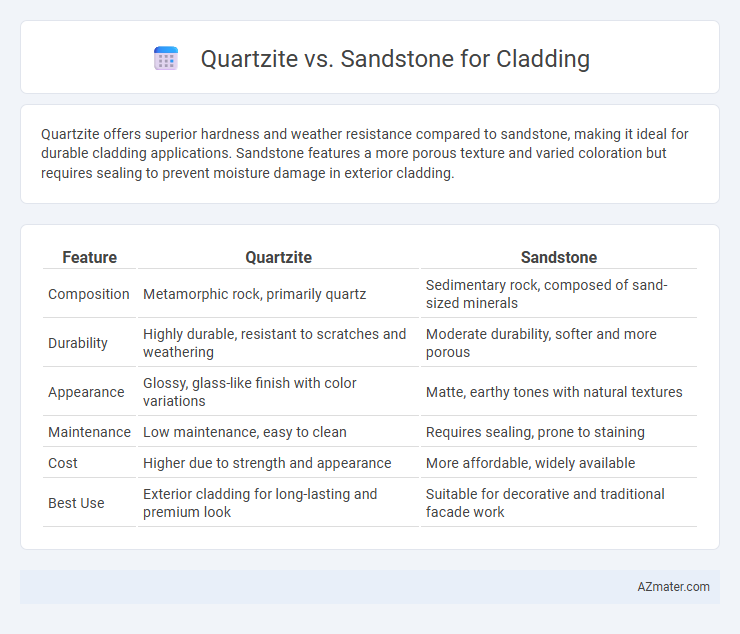Quartzite offers superior hardness and weather resistance compared to sandstone, making it ideal for durable cladding applications. Sandstone features a more porous texture and varied coloration but requires sealing to prevent moisture damage in exterior cladding.
Table of Comparison
| Feature | Quartzite | Sandstone |
|---|---|---|
| Composition | Metamorphic rock, primarily quartz | Sedimentary rock, composed of sand-sized minerals |
| Durability | Highly durable, resistant to scratches and weathering | Moderate durability, softer and more porous |
| Appearance | Glossy, glass-like finish with color variations | Matte, earthy tones with natural textures |
| Maintenance | Low maintenance, easy to clean | Requires sealing, prone to staining |
| Cost | Higher due to strength and appearance | More affordable, widely available |
| Best Use | Exterior cladding for long-lasting and premium look | Suitable for decorative and traditional facade work |
Introduction to Quartzite and Sandstone Cladding
Quartzite cladding offers exceptional durability and resistance to weathering, making it a prime choice for exterior applications where strength and longevity are crucial. Sandstone cladding is valued for its natural texture and warm tones, providing aesthetic versatility and ease of installation in various architectural styles. Both materials deliver unique benefits, with quartzite excelling in hardness and sandstone favored for its breathability and classic appeal.
Geological Formation and Properties
Quartzite forms from the metamorphism of sandstone under intense heat and pressure, resulting in a highly durable and dense rock composed primarily of quartz crystals. Sandstone, a sedimentary rock made of compacted sand grains bound by mineral cement, exhibits greater porosity and lower hardness compared to quartzite. Quartzite's superior resistance to weathering and abrasion makes it ideal for exterior cladding, while sandstone's permeability requires additional sealing for long-term durability in building facades.
Aesthetic Differences: Appearance and Color Variations
Quartzite exhibits a glassy, translucent quality with sharp, crystalline patterns, offering a sleek, modern aesthetic ideal for high-end cladding projects. Sandstone features a more granular texture with earthy, muted tones, creating a warm, rustic appearance suitable for traditional and natural-inspired designs. Color variations in quartzite range from white to blue-grey and pink, while sandstone presents hues of beige, red, and brown, each influencing the overall visual impact of exterior facades.
Durability and Weather Resistance
Quartzite exhibits superior durability and weather resistance compared to sandstone due to its higher quartz content and natural hardness. Its dense, non-porous structure ensures minimal water absorption, reducing the risk of erosion, freeze-thaw damage, and staining in exterior cladding applications. Sandstone, while aesthetically versatile, is more prone to weathering, requiring regular sealing and maintenance to prevent surface degradation and moisture penetration.
Installation Process and Techniques
Quartzite cladding installation requires precise cutting and handling due to its hardness and density, often necessitating diamond-tipped tools and professional expertise to prevent cracking. Sandstone, being softer and more porous, allows for easier cutting and shaping but demands careful sealing post-installation to enhance durability and prevent moisture absorption. Both materials benefit from mechanical fixing systems or adhesive methods, with the choice influenced by the building structure and environmental exposure.
Maintenance Requirements and Longevity
Quartzite offers superior durability and low maintenance for cladding projects due to its extreme hardness and resistance to weathering, ensuring long-lasting performance. Sandstone, while aesthetically pleasing with its natural texture, generally requires more frequent sealing and repairs to prevent erosion and staining over time. Choosing quartzite reduces upkeep costs and extends cladding longevity, making it ideal for high-exposure exterior applications.
Cost Comparison and Affordability
Quartzite cladding typically costs between $70 and $100 per square foot, making it a premium choice due to its durability and natural resistance to weathering. Sandstone, on the other hand, ranges from $40 to $70 per square foot, offering a more affordable option while still providing good aesthetic appeal and moderate durability. When deciding between quartzite and sandstone for cladding, budget constraints often favor sandstone, but quartzite's long-term value and lower maintenance costs may justify its higher initial investment.
Environmental Impact and Sustainability
Quartzite offers greater durability and resistance to weathering compared to sandstone, resulting in longer lifespan and reduced need for replacement in cladding applications. Sandstone, typically sourced more locally and being less energy-intensive to quarry and process, often has a smaller carbon footprint despite its lower durability. Choosing quartzite can contribute to sustainability through longevity, while sandstone supports environmental impact reduction via lower extraction emissions, making each suitable depending on project priorities.
Ideal Applications and Design Flexibility
Quartzite offers superior durability and resistance to weathering, making it ideal for high-traffic exterior cladding where longevity is essential. Sandstone provides greater design flexibility due to its softer texture and range of earth tones, allowing for intricate carvings and varied architectural styles. Both materials enhance aesthetic appeal, but quartzite suits modern, sleek facades while sandstone complements rustic and traditional designs.
Choosing the Right Stone: Quartzite or Sandstone?
Quartzite offers exceptional durability, high resistance to weathering, and a glassy, vibrant appearance, making it ideal for exterior cladding in harsh climates. Sandstone provides a softer texture and greater workability, with warm earthy tones that enhance traditional or rustic architectural styles. Selecting between quartzite and sandstone depends on balancing durability requirements with aesthetic preferences and maintenance considerations for long-lasting cladding solutions.

Infographic: Quartzite vs Sandstone for Cladding
 azmater.com
azmater.com